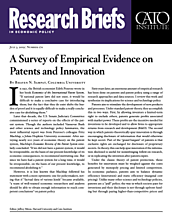Later that decade, the U.S. Senate Judiciary Committee commissioned a series of reports on the effects of the patent system. Though the authors included Vannevar Bush and other science and technology policy luminaries, the most influential report was from Penrose’s colleague Fritz Machlup, a Johns Hopkins University economist. After surveying nearly 200 years of economic theory on the patent system, Machlup’s Economic Review of the Patent System similarly concluded: “If we did not have a patent system, it would be irresponsible, on the basis of our present knowledge of its economic consequences, to recommend instituting one. But since we have had a patent system for a long time, it would be irresponsible, on the basis of our present knowledge, to recommend abolishing it.”
However, it is less known that Machlup followed his statement with a more optimistic one for policymakers, noting that if “factual data of various kinds” became available, “a team of well-trained economic researchers and analysts should be able to obtain enough information to reach competent conclusions” on patent policy.
Sixty years later, an enormous amount of empirical research has been done on patents and patent policy, using a range of research approaches and data sources. I review this work and synthesize its implications for science and technology policy.
Patents aim to stimulate the development of new products and processes. Under standard patent theory, they accomplish this in two ways. First, by allowing inventors a limited-term right to exclude others, patents generate profits associated with market power. These profits are the incentive needed for inventions to be developed and to allow firms to appropriate returns from research and development (R&D). The second way in which patents theoretically spur innovation is through encouraging disclosure of information that would otherwise be kept secret. Part of the “grand bargain” of patents is that exclusive rights are exchanged for disclosure of proprietary secrets. In theory, this can help spur innovation if the information disclosed is useful for non-infringing follow-on research, or in replicating the invention after patents expire.
Under the classic theory of patent protection, these benefits for innovation must be weighed against the costs generated by monopoly pricing and limited competition. In economic parlance, patents aim to balance dynamic efficiency (innovation) and static efficiency (marginal cost pricing). Unlike many other science and technology policies, patents are a “pull” policy; the way in which society pays for inventions and their disclosure is not through upfront funding but through paying higher-than-competitive prices andhaving restricted output until the patents expire.
While this framework would have been familiar to Penrose, Machlup, and their contemporaries, other economists have recognized that in some contexts and fields innovation is not a one-shot deal but is cumulative. Today’s research outputs can be inputs into tomorrow’s follow-on innovation. The effects of patents on innovation are more complicated in this case, since stronger patents could create incentives for first-generation innovation but make second-generation innovation costlier or more difficult. This is not just a theoretical concern but has been one of the central concerns in patent policy in recent years.
Several conclusions emerge from the review:
- The effects of patents on innovation incentives are stronger in some sectors (e.g., pharmaceuticals and chemicals) than in others. The effects of patent policy on innovation are likely to be sector specific, as are the costs and benefits of strengthening or weakening patent protection. An optimal patent policy would be sector specific.
- Patents are used differently across fields. In some fields, they are important to firms appropriating returns from R&D. In others, they are less important for this purpose but are used for other strategic purposes.
- A considerable amount of innovation occurs outside the patent system. Strengthening of patent protection leads to changes in patenting and patent propensity, but this is not necessarily correlated with more innovation.
- In a global environment, strengthening national patent laws outside the United States does not seem to matter much for domestic R&D or innovation. Even in pharmaceuticals, the sector where patents are most important, domestic patent protection has limited impact on measured R&D and innovation.
- Stronger patent protection does not appear to generate R&D for tropical diseases. For high-social-value investments without significant markets, patents are unlikely to have a strong effect. Other mechanisms, including prizes or public funding, may be needed.
- Despite much commentary to the contrary in the theoretical literature, firms do seem to read patents for information and learn from them. The design of patent systems and specific rules surrounding disclosure may affect the extent of disclosure of useful information in patent documents. However, the quantitative effects of the disclosure function of patents on rates of innovation are not well known.
- Evidence for the claim that patents hinder follow-on innovation is mixed. Most of the work specifically focused on the life sciences — where policy concerns have been greatest — can reject any strong negative impact that patents have on follow-on innovation. In general, the research points to the heterogeneous effects of patents on cumulative innovation: the effects appear to depend on the type of knowledge patented (tangible vs. intangible), the locus of potential follow-on researchers (public vs. private), technology field, and various other institutional factors.
Many of the issues stated above (especially the last three) are topics of ongoing research. While it would be foolish to make definitive statements on most of these issues, we can move past the extreme uncertainty expressed by Penrose, Machlup, and others and provide some guidance for policymakers on these issues. This represents an initial payoff from the large body of empirical research on patents that has been conducted over the past decades.
NOTE:
This research brief is based on Bhaven N. Sampat, “A Survey of Empirical Evidence on Patents and Innovation,” NBER Working Paper no. 25383, December 2018, http://www.nber.org/papers/w25383.

